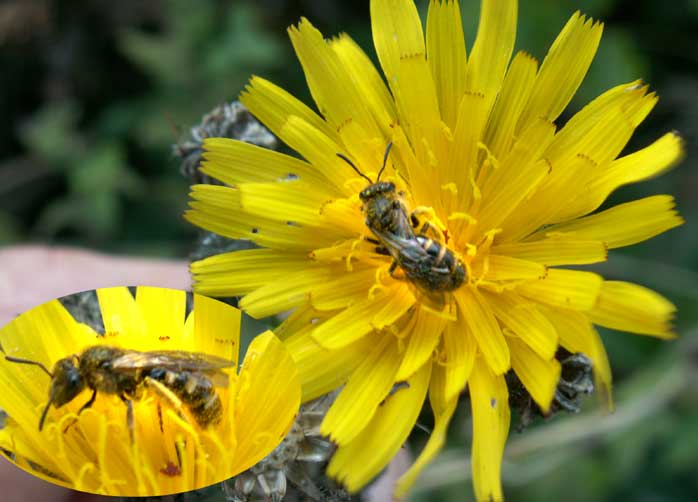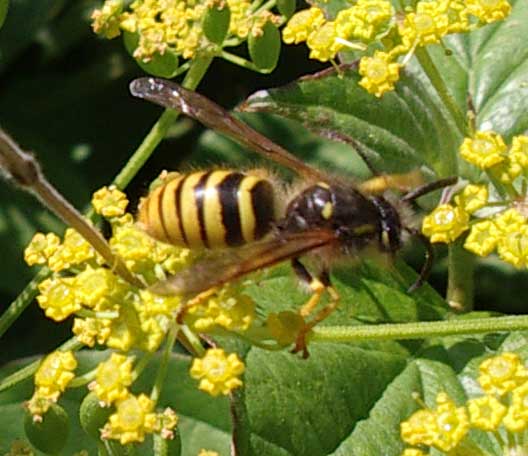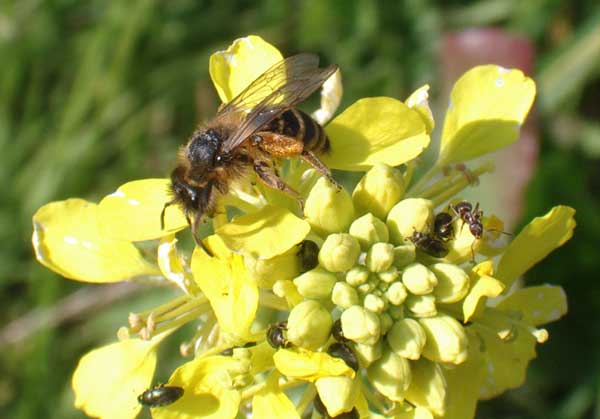-
Adur
Bees,
Wasps
& Sawflies etc.
-
excluding
Bumblebees
-
-
-
Link
to Bees etc. 2009
-
-
If IDs are not confirmed,
do not quote please
-
-
17 May
2009
-
 |
 |
This bee was identified
as such from its antennae.
A male Osmia rufa.
|
-
-
22 April
2009
-
Three
kleptoparastic
(cuckoo) bees Nomada
fucata were spotted in the morning,
the first skulking amongst the Alexanders
at the top of Buckingham Park, the second in the Mill Hill Cutting (south
west) and the third on the lower slopes of Mill
Hill.
-
Nomada
fucata Information
-
13
July 2008
Robin's
Pin Cushion created by groups of larvae
of the Gall Wasp, Diplolepis rosae,
was
seen on the lower slopes of Mill
Hill where it is a regular occurrence. |
 |
 |
20
April 2008
This
small
bee was discovered on a Dandelion
in a clearing of the linear spinney on the south side of the Slonk
Hill Cutting. This could be a Nomada
species.
A male
Nomada
goodeniana.
|
30
March 2008
I
did not note where this Andrena sp.
(ID ??) bee
was seen, but it was almost certainly in or near the Butterfly Copse next
to the Waterworks
Road.
It
was probably Andrena
flavipes.
|
|
26
March 2008
A
Queen
of the
Common Wasp, Vespula vulgaris,
crawled
over an Alexander flower on the route to the Buckingham
Cutting at the top of The Drive, Shoreham. |
|
11
February 2008
I
was surprised by my first Honey Bee
of the year on the southern bank of the Mill
Hill Cutting at the western end. It looked big enough to be a Queen.
Honey
Bees on Wikipedia

16
September 2007
-
At the
northern end of the
lower slopes of Mill
Hill, near the Devil's Foot Scabious,
I was attacked by a swarm of twenty or so Common
Wasps* and despite making a run for it,
I was stung at least six times mainly on my scalp and the stings could
be felt four hours afterwards. It felt like a very strong nettle sting
with a mild location specific headache after four hours had elapsed. My
skin did not appear to have been broken, but because it was under my hair
on the back of my head, I could not see this. There did not appear to be
any swelling. (*I did not stay around to ascertain
the precise species.) Later, two days later,
I discovered a pin-prick mark around my left sideburns near the ear and
another one on my cheek which were wasp stings and both of these were remembered
as were two on my scalp which could not be seen.
-
-
4 July
2007
-
A solitary
digger wasp in the genus Ectemnius
was seen in the north-west part of Mill
Hill. These wasps are predators
on large flies.
-
3
July 2007
This
is one of the common species of solitary bees, probably Andrena
sp. This was seen on the south side of
the Slonk Hill Cutting, but they could be found
almost anywhere on the wasteland on the outskirts of Shoreham.
PS.
This could be a wasp? |
 |
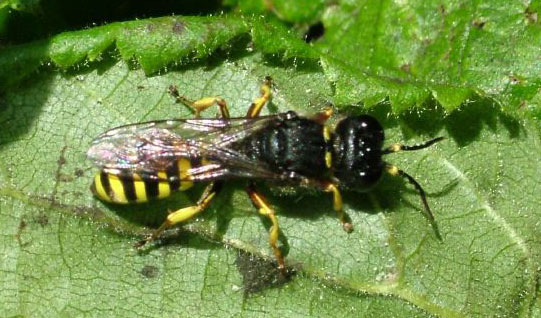 |
1
July 2007
A
solitary wasp in the genus Ectemnius
visited my south Lancing garden at TQ 186
044.
|
-
-
10 June
2007
-
A Leaf
Cutter Bee, Megachile sp.
rested on the wooden hand rail in the Butterfly Copse next to the Waterworks
Road.
-
-
27 April
2007
-
-

-
An ichneumon
wasp was recorded from the Pixie
Path to Mill Hill. From
Chinery
I think it could be Pimpla
instigator but it has not been confirmed.
-
Mapmate
Ichneumonidae Checklist
-
Ichneumonidae
(Wikipedia)
-
-
24 April
2007
-
A Nomada
kleptoparastic
(cuckoo) bee was recorded at Cuckoo's
Corner. It was skulking and hiding too much to get a photograph.
-
-
16 April
2007
-
Brown
female Spring
(Hairy-footed) Flower Bees, Anthophora
plumipes, buzzed noisily in
the sunshine. I only saw one, but others were reported from the lower
slopes of Mill Hill.
14
April 2007
Three
Red
Mason Bees, Osmia
rufa, visited my garden in residential
Shoreham. They seemed to be attracted to the Garden Privet.
10
April 2007
There
was a lot of buzzing in my front garden in
residential Shoreham, with my first female
Spring
(Hairy-footed) Flower Bee of the year that visited
the flowering Rosemary
and exceeded the buzzing of the queen Buff-tailed
Bumblebee which buzzed around elsewhere. |
 |
9
April 2007
This
Andrena
bee (? ID)
was
seen on an Alexander on the southern part of Mill
Hill. |
|
-
5
April 2007
-
-
-
This wasp
was just the one on Alexanders on the
Public
Footpath
3138 section of the Waterworks
Road south. It is a Queen
of the Common Wasp, Vespula vulgaris.
-
-
24 March
2007
-
An interesting
orangey coloured Andrena bee briefly
visited the flowering
Rosemary
by the front door of the Hamblett's
south Lancing (TQ 186 044) front
garden. This was similar to the bee seen on Mill
Hill three days previously.
-
Adur
Solitary Bees
-
21
March 2007
-
An interesting
orangey Andrena bee
entered a small hole in a small earth bank on the lower
slopes of Mill Hill. It did not come
out of the hole so I could not identify what species of bee
it was. My best guess would be Andrena
flavipes. However, the one seen may be
a slightly larger species?
-
 |
 |
This is the pencil sized
hole in the earth bank that the mining bee entered. The vertical earth
patches may have been created by Rabbits attempting
to burrow or by uprooted Privet, or by erosion by other natural forces. |
-
27
August 2006
Several
Ichneumon
Wasps
were
seen on the Ivy in the in the Butterfly Copse next to the Waterworks
Road, It was a very small species and it was difficult to photograph.
It, or similar species" and widespread and frequently seen.
There
are dozens of very similar species.
From
Chinery
I think it could be Pimpla
instigator but it has not been confirmed. |
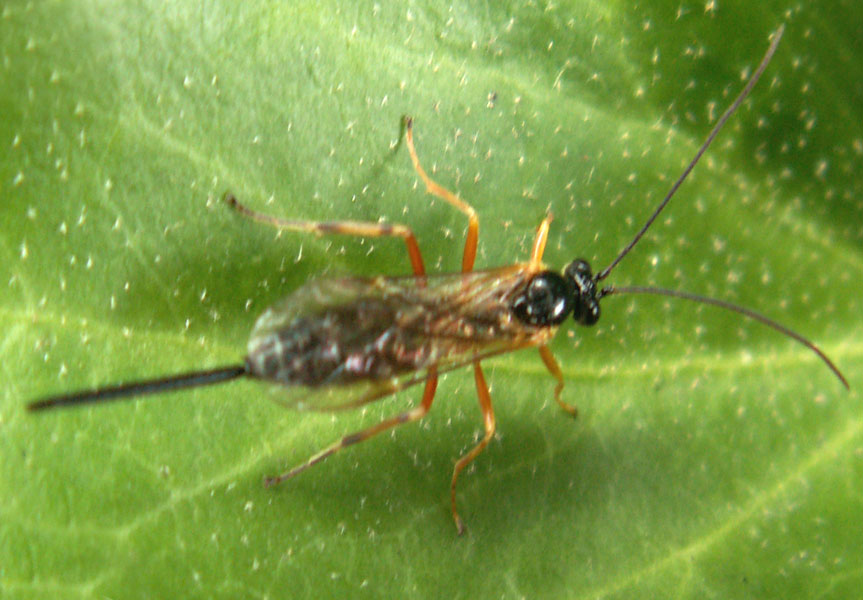 |
| Common
Wasp Queen |
 |
30
July 2006
A
Leaf
Cutter Bee, Megachile sp.
was
seen on the south part of Slonk Hill in tall
vegetation next to the path.
23
July 2006
The
first one, a sawfly, was spotted, probably on Cow Parsley on south side
of the Buckingham Cutting.
The
second sawfly was seen on Yarrow on the top meadows of Mill
Hill.
They
may be the same species. Tenthredo arcuata
is my suggestion. If it is this species, the adult preys on small flies.
29
June 2006
A
species of wasp
was discovered near the Butterfly Copse next to the Waterworks
Road.

|

|
|
Xanthogramma
pedissequum
This
hoverfly
can be recognised in flight by the the yellow stripes on the side of its
thorax. It hovered in mid-air frequently.
|
This
is a wasp
(Superfamily:
Vespoidae)
(ID
to species not confirmed)
Hovering
was spasmodic and not distinctive, with more flitting about than hovering.
|
A hoverfly
and a wasp are shown next to each other to contrast or compare their appearances.
The
wasp looks like one of the Digger Wasps
illustrated on Chinery "British Insects" on
page 237.
15
June 2006
The
species has been frequently seen before.
Tenthredo
arcuata agg.
This
is a Tenthredo of
the arcuata/acerrima/schaefferi
group. It is female, which means that it can be identified, but only
by examination of the saw.
The
yellow flower (Silverweed or Creeping Cinquefoil)
was seen on the upper plateau of Mill Hill.
|
 |
 |
 |
28
May 2006
The
wasp
mimic is a hoverfly,
a species of Chrysotoxum
in the dense meadows north-west of the upper car park on
Mill
Hill. |
10
May 2006
A
Spring
(Hairy-footed) Flower Bee with
a long tongue buzzed
around the flowering Rosemary in
my front garden.
7
May 2006
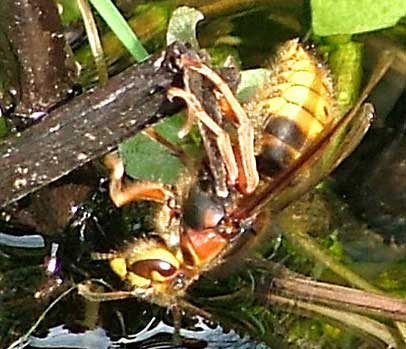 |

Red
Mason Bee
|

Leaf Cutter Bee
|
The
two bees photographed above (on
the right) were seen in a north Shoreham garden.
I think the first one is a Red Mason Bee,
Osmia
rufa, and the second one is a Leaf Cutter Bee, Megachile
sp. The orange bee was a keen visitor to Bluebells.
3 May
2006
A
Hornet,
Vespa
crabo, (illustrated
above) visited my garden pond in south Lancing
for a drink. This large wasp is uncommon and
probably unwelcome. It has a reputation
to possess a powerful sting.
Queen
Vespula
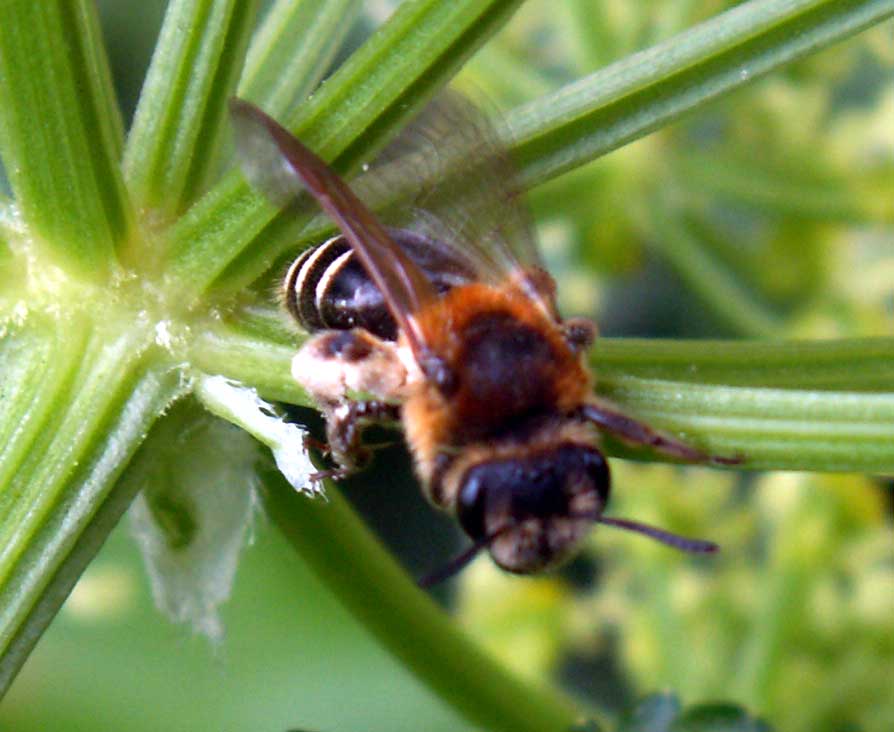 2
May 2006
2
May 2006
-
One Alexander
at the top of the Butterfly Copse next to the Waterworks
Road was visited by a small bee Andrena
dorsata.
-
Solitary
Bee Portraits
1 May
2006
-
May came
in with a shower. On the lower
slopes of Mill Hill, small bees
visited the Dandelions
and there were scores of these and I think the species is Lasioglossum
calceatum.
-
-
26 April
2006
-
The first
record this year of the Spring (Hairy-footed) Flower Bee,
Anthophora
plumipes buzzed around a north Shoreham garden.
It seemed to be attracted to Spotted Deadnettle,
Lamium
maculatum (pic).
It was seen again about two days later in the same garden.
 9
April 2006
9
April 2006
At
the top of the Butterfly Copse (Old Shoreham next to the Waterworks
Road), a flowering Cherry Plum Tree
attracted scores of Andrena bees,
altogether at least one hundred and most of them amongst the flowers high
in the tree and out of camera range. This one was probably Andrena
flavipes; it seems to match the photographs,
and it is a common species at this time of the year. The problem is about
half a dozen of the Andrena
look almost identical without examination under a microscope. A species
of Andrena bee is
the host for the larvae of the attractive and rare Dotted
Bee-fly.
The
only thing of note on the lower slopes
of Mill Hill was one of small
Lasioglossum
bees on a solitary Dandelion.
It was the same one as illustrated below.
British
Insects: Hymenoptera, Andrenidae
 |
 |
6
April 2006
This
looks like a tiny bee
on a Daisy. There
were probably at least two more on a Dandelion
in
the middle Triangle area of Mill Hill.
Could
it be a Lasioglossum |
6 February
2006
The
first
Honey Bee
recorded this year was photographed
on the Lancing Ring Nature Reserve.
February
Blogspot Report from Lancing Ring
 |
21
June 2005
This
wasp,
maybe Ectemnius
continuus visited the rotting
log by the pond in my south Lancing garden at TQ
186 044.
|
10
May 2005
There
were at least five of the kleptoparastic (cuckoo)
bees Nomada fucata in
two minutes but
only one of its victim the mining bee Andrena
flavipes seen amongst the Elm leaves
in the centre of New Monks Farm.
7
May 2005
New
Monks Farm Insects
The
first one is a Nomada kleptoparastic
(cuckoo) bee.
The
photograph on the far right is an Andrena
Mining Bee.
The
bee in the first two pictures is Nomada
fucata, a parasite of the mining bee
Andrena
flavipes (and only parasitic on this
species) in
the photograph on the right which was discovered within a metre of the
first bee. (TQ
188 049) Nomada
fucata is now widely recorded from southern
England.
The
Nomada
bee was first spotted by Ray
Hamblett.
There
are unconfirmed earlier observations of Nomada
fucata from the Pixie
Path and the lower slopes of Mill
Hill.
The
method of kleptoparasiticism is that the parasitic Nomada
bees
lay their eggs into the nest cells of their Andrena
hosts.
Brief
Extra Information
1 May
2005
An
Andrena
bee
was noted on a Dandelion
in
the copse at the top of Mill
Hill. This a common genus of bees seen in many wild locations at this
time of the year.
17
April 2005
The
Spring
(Hairy-footed) Flower Bee* with
a long tongue and a loud buzzing
sound in a Shoreham garden,
was misidentified as a bee-fly at first. It was not a
fly at all, but a solitary
bee called Anthophora
plumipes. It is a female (they are black) and the males are
brown. The straightforward conclusion is the intruder with which it appeared
to be fighting was the male of the same species and they were mating.
Full
Report with Photographs
Shoreham
Town & Gardens
Web
Site with Photographs
10
April 2005
There
was what looked like an Andrena
Mining
Bee (illustrated below), probably Andrena
flavipes, on
yellow flowers of Oil Seed Rape
on the south-facing
A27
road embankment north of the Dovecote
Estate, Shoreham. In the first picture (below),
there are Pollen Beetles, Meligethes
and a Black Ant of an unknown genus.
Adur
Beetles
Andrena
emergence in Shrewsbury (photographs)
3 April
2005
This insect photographed
above on a Dandelion at the top
of The Drive, Shoreham looks familiar, but it does not seem to have
been photographed before.
Note the slender "waist"
though. It was not seen hovering. This is a Mining Bee? Andrena
?
Certainly
not a hoverfly, it has two pairs of wings. I printed off a copy and used
a magnifying glass, looked at the wing venation [using
Willmer] 3 SM cells; BV straight; D1 rhomboid;
SM2 < SM3; hairy, brownish; the rest difficult to see but heading for
Andrena
sp. However, look at the abdominal
segment nearest the "waist" - I don't have a completely sharp pic - but
I think I can
see
something protruding from between the segments at the left hand side?
What do you think? Considering that the lethargic bee I found on a dandelion
flower [mine
was identified by Stuart
Roberts as
Andrena chrysosceles]
was parasitised by 3 x female Stylops, it looks v. similar to your bee.
Andrena
shortlist
Solitary
Bee Information
There
are over 200 species of solitary bees found in Britain and, like the social
bees (the bumblebees and the honey bee), they all feed on pollen and nectar
and they are important pollinators of many garden flowers and commercial
crops. Solitary bees have no 'workers' and each female builds only a small
nest, which she stocks with a large quantity of pollen - enough to provide
all the food needed by her future offspring. After laying her eggs, the
female bee seals and abandons the nest and soon dies, leaving her offspring
to develop on their own.
Order
Hymenoptera - Sawflies, Wasps, Ants & Bees
7
August 2004
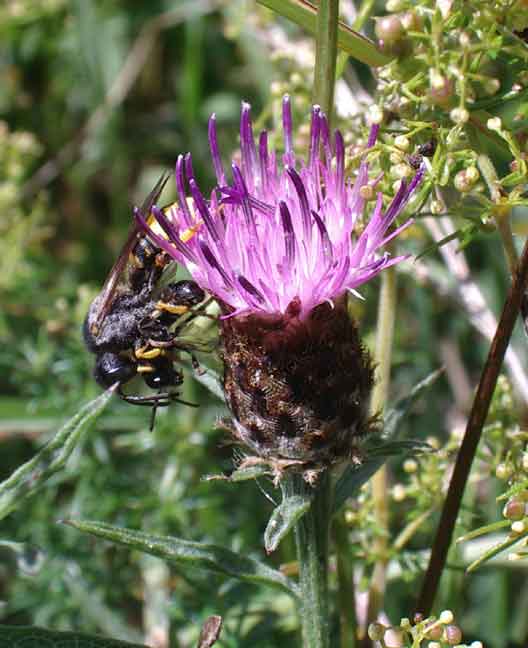 |
There
are two insects in this picture from Mill
Hill.
I have
identified the top one as possibly a Digger
Wasp, Cerceris
rybyensis, which has attacked the small bee which it will paralyse
and then kidnap.
|
| 30
June 2004
A Leaf Cutter Bee
Megachile
sp.
Shoreham
garden |
|
 |
Adur Insect Links:
Bumblebees
Hoverflies
Butterflies
Solitary
Bees
Mining Bees
Flies
Beetles
Ladybirds
Moths
Grasshoppers
& Crickets
Damselflies
&
Dragonflies
Glow
Worms
Other
Links:
Bee-killer
Wasps (David Element)















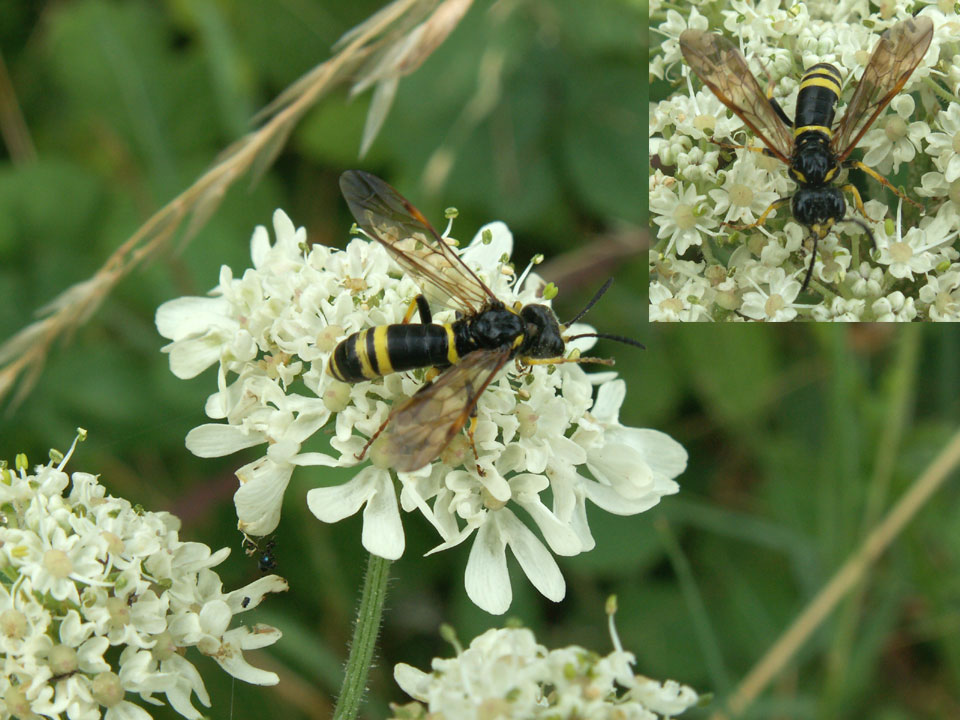










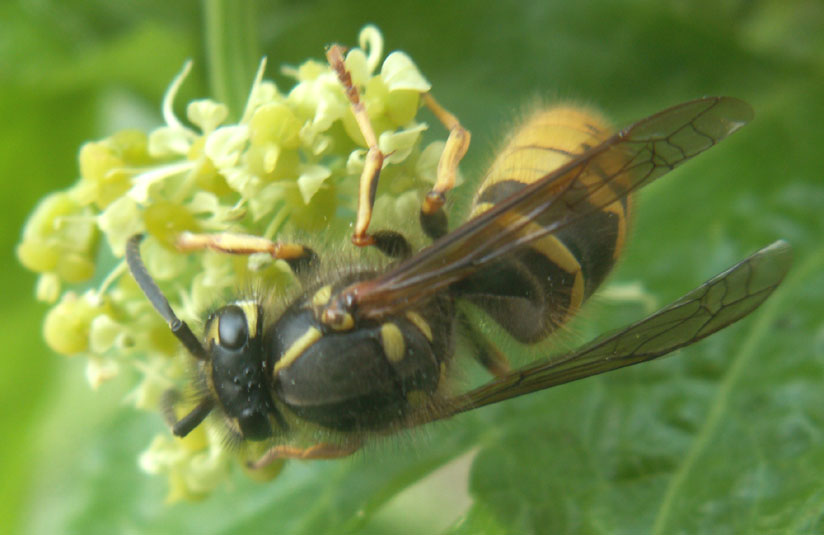





 9
April 2006
9
April 2006


